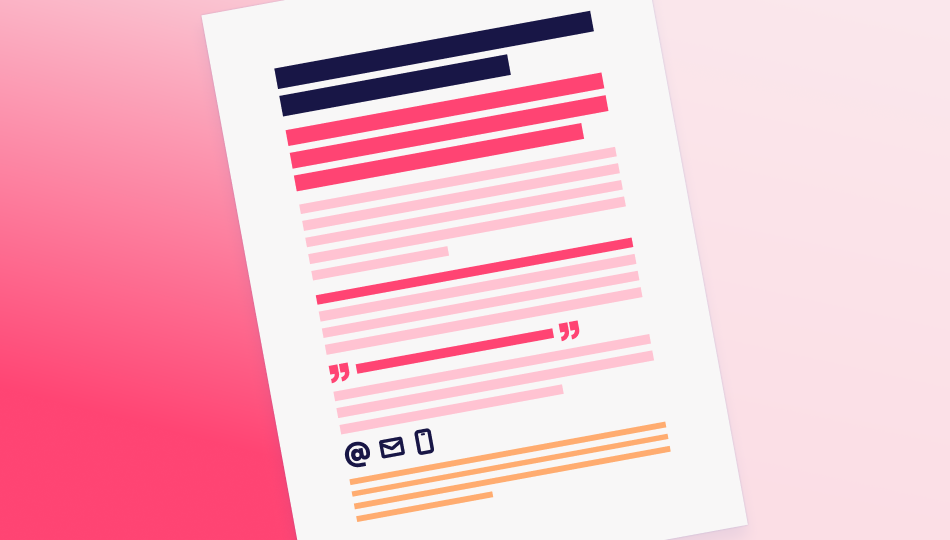Wherever you turn, you encounter various types of content across multiple channels. As a result, the standards for content continue to rise, making it challenging for PR and Communication professionals like yourself to cut through the noise. However, it also presents opportunities, since reliable and engaging content is highly valued. Press releases are examples of content that both media and consumers view as trustworthy sources of information. But what is a press release? And how do you write an effective press release? Learn all of this and more in our blog post!
What is a press or media release?
Before learning how to write a press release, you must understand what it is. A press release, also known as a media release, is simply an article summarizing for example company news in a concise format. Well-crafted press releases include a clear news angle and the company’s message. In this blog post, you’ll learn how to maximize impact when writing and publishing a press release.
What to do before writing a press release
Even if you’re eager to draft your press release immediately, doing some groundwork always pays off. Here are some things to consider before writing press releases:
Ensure your topic is relevant
Before communicating, always consider whether what you want to share is valuable to others or not. If you find this challenging to determine, ask yourself the following questions:
- Timing – is your topic current? What are people talking about right now?
- Identification – can your target group identify with your story?
- Significance – is the content interesting for your target group?
- Worth reading – is the content unique, inspiring, or educational?
A great way to increase the newsworthiness of your topic or angle is to stay updated on news and trends related to your industry. Media monitoring makes it easy for you to keep track of what is being said about your brand, competitors, and industry—and to identify trends over time.

Consider angle and purpose
Think about what you want to convey, and focus on a main topic in your press release. If you want to cover multiple topics, create separate press releases to do so. Try to answer the questions what, where, who, why, when, and how?
Also, define the purpose of your press release. Once that is set, you’ll find it easier to communicate your story. Understanding who your audience is and what specific goal you want to achieve becomes more clear as well.
The four most common goals for press releases are to share:
- News: A new report, a new initiative, a publication, and so on.
- Opinions: A reaction to a current issue or a desire to initiate a new debate.
- Knowledge: Factual knowledge about a specific topic relevant to the media; make them aware and become a source for continued reporting.
- Media briefs: Hints that something new is coming. This way, you prepare for when the company releases big news about a product, initiative, publication, or similar. You might not get media coverage, but you invest time in preparing the journalists.
Identify your target audience
How do you maximize the impact of your press release? By reaching the right people with your message! You may have a contact list with customers, media personalities, journalists, and other stakeholders that you’ve collected. These contacts are valuable since they have shown interest in your previous content. Perhaps you’ve organized your contacts by interests, past interactions, engagement, and/or coverage. Evaluate your contacts and add them to the audience that you believe would find value in your upcoming press release.
In addition to your existing contacts, try finding new journalists to expand your reach. Keep in mind that journalists are supposed to cover stories that fit their audience and interests. If you find the right journalist, they will view your news as an asset.
To find the right journalist, you need to do some basic fieldwork: read newspapers, listen to the radio, watch TV, and browse some websites. Not only does this give you an overview of what a specific media organization is interested in, but also individual journalists. Are you intrigued, but think it sounds like too much work? In that case, use Mynewsdesk’s AI CoPilot to help you find relevant media contacts in no time!

Write a press release in 8 simple steps
Now it’s time to start creating the actual press release! Here are 8 steps you can follow to draft a great press release.
1. View the news objectively
A press release requires a pragmatic tone. To achieve this, consider a few things. Never write “we” but “they,” as if you were reporting from an external perspective. Avoid exclamation marks or judgmental and euphemistic descriptions; strive to be as neutral as possible. An exception is quotes, which are effective for expressing emotions and opinions.
2. Engaging headline and preamble
The headline of the press release is what captures a reader’s attention. That makes it very important. Oftentimes, it’s easier to come up with an interesting headline when you’ve finished writing the release. The headline should be no more than 40 characters and contain the core of the news. The headline will also be the subject line for those receiving the press release via email. Avoid long words and the term “press release.”
Following the headline is the preamble, which should summarize the content of your text. It should be written in bold and is usually a few sentences long, roughly two to four. Sometimes, starting with writing the preamble may help you to convey the main points. Other times, it’s easier to write the preamble when you have a finished text to summarize.
3. Keep it short and interesting
Ensure that your press release captures the recipient’s interest, and keep it concise. Write simple and to the point, avoiding complicated jargon. Also, structure your press release to make it easy to read, for example by using subheadings. This makes it easy for a journalist to edit and republish your text. Your company’s name should also be visible both in the press release itself and in the subject line of the emails containing the press release, to clearly display the sender.
4. SEO-optimize to reach more people
By optimizing your press release for search engines, you increase the chance of reaching a broader audience when you publish it. Search engines are an excellent way to reach people actively searching for information on the topic you’re writing about. Consider which keywords to use and review the readability of your text. SEO is clearly more complex than that, but assuming your company has a strong domain, monitoring keywords and readability is a good starting point. One way to enhance visibility is by publishing your press release in a newsroom with Mynewsdesk, as the entire site has a strong SEO ranking.
5. Enhance impact with a CTA
A press release is an excellent opportunity to link to other related content. Do so by concluding your press release with a call-to-action (CTA). A CTA is used to encourage a reader to take some form of action. Examples of CTAs include “Buy now” in online stores or “Read more” links in articles or newsletters. In a press release, you can link to other related news, your website, or other relevant material.
6. Finish off with a boilerplate
There should always be a boilerplate at the end of your press release. A boilerplate is a short, standardized text about what your organization does, including details such as the company’s size, industry, and more. If you’re part of an international organization, your boilerplate should be available in local languages. Include your boilerplate in all press releases to be consistent and make it easy for journalists, as they should be able to copy it.
7. Boost your press release with images and videos
You’ve finished drafting the press release, but you’re not done yet! Adding high-resolution, relevant images or videos to your press release is crucial in order to get it covered by media. This way, journalists have all the material they need to create a complete article. A rule of thumb is that images that are to be used in newspapers or on the web should be about 1 MB. For printed magazines, they should be larger than 3 MB. Also, provide journalists with information on where they can access the images, such as a link to your newsroom on the website, contact details to the public relations officer, or similar.
8. Publish and send the press release
There are several ways to distribute your press release, but publishing it in your newsroom is a good start. When you gather all press releases in one place, it gets easier for journalists to keep track of all your news, enabling them to spread your messages. Therefore, the first step after finishing a press release should be to publish it.
So, when should you send press releases, and to whom? By sending press releases via email to your network of journalists and other stakeholders, you increase the chances of someone picking up the news. Therefore, you should always send press releases to increase the chance of your news spreading. If you need help expanding your existing network, Mynewsdesk can assist with media contacts!

Follow up on your press release
Your press release is published – now the fun begins! It’s time to shift focus and explore what happens after publication.
Evaluate the exposure
Did your press release get the reach you expected? Did you reach your target audience? Using data and analytics tools, you can see the traffic and engagement for your press release, as well as any mentions by media or individuals. These insights can provide valuable information on how your press release performed.
Analyze clicks, shares, and downloads
Depending on how you distributed your press release, you can evaluate opened email messages, clicks on links, shares, and downloads of related material. These insights are an excellent way to assess engagement among your target audience.
Draw conclusions
Don’t just settle for evaluating and analyzing. Use the insights you gained after publishing your press release to improve how you work in the future. How can you develop your communication to reach even more people, increase relevancy, and build stronger relationships with your audience? One way to simplify analyzing and measuring the impact of your PR efforts, is by using Mynewsdesk.

Get started with a press release template
As you’ve come to realize, there’s a lot to consider when writing a press release. To get even more out of your next press release, you can follow our 8 simple steps, but you can also use our press release template to succeed. With a press release template, getting started is easy!
Summary of our press release tips
Now you’ve learned what a press release is and how to write an effective press release. Getting attention in the media gives high credibility which is challenging to achieve through advertising and promotional campaigns, making press releases effective and essential in your communication strategy.
Before you start your press release, prepare by evaluating how newsworthy your topic is, considering the angle and purpose, and identifying your target audience. When it’s time to write, follow our 8 simple steps to succeed with your press release. Finally, it’s crucial to analyze the results of your press release after publication. Good luck!



